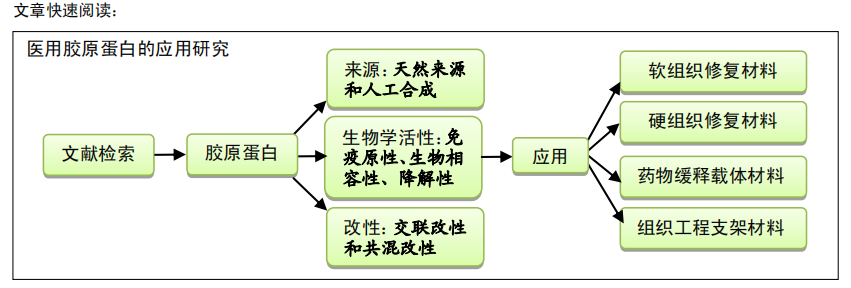
伤口世界

- 星期二, 28 5月 2024
胶原蛋白作为医用生物材料对缺损组织修复、再生及重建的作用与意义
胡 康1,张 伟2 ( 1广东冠昊生物医用材料开发有限公司,广东省广州市 510530;2冠昊生物科技股份有限公司,再生型医用植入器械国家工程实验室,广东省广州市 510530)
DOI:10.3969/j. issn.2095-4344.0650 ORCID: 0000-0002-7923-2706(胡康)
胡康,男,1992 年生,湖北省仙桃市人,汉族,2017年华南理工大学毕业,硕士,主要从事医用生物材料的研究与开发研究。
通讯作者:张伟,中级工程师,冠昊生物科技股份有限公司研发部,广东省广州市 510530

文题释义:
胶原蛋白:是生物高分子材料,为动物结缔组织的主要成分,是哺乳动物体内含量最多、分布最广的功能性蛋白,占蛋白质总量的 30%左右;具有良好的生物相容性、低免疫原性和组织可降解吸收性,在创面止血、愈合,缺损组织的填充、修复及重建,药物载体和组织工程等方面有广泛应用,是理想的医用生物材料。医用生物材料:是用来对生物体进行诊断、治疗、修复,或替换其病损组织、器官及增进其功能的材料,包括金属、陶瓷、高分子、复合材料等。
摘要
背景:胶原蛋白因具有低免疫原性,良好的生物相容性和生物降解性,在医用生物材料方面得到广泛应用。
目的:综述近年来国内外胶原蛋白的来源、生物活性、改性及其在医用生物材料方面的应用进展。
方法:通过计算机检索 2010 至 2018 年 PubMed、Elsevier、Springerlink、中国知网等数据库发表的相关文章,英文检索词为“collagen,crosslinking,immunogenicity,biocompatibility,tissue engineering”,中文检索词为“胶原蛋白,交联,免疫原性,生物相容性,组织工程”。
结果与结论:胶原蛋白主要从动物肌腱、皮肤、尾巴等组织中提取获得的,具有良好生物相容性、低免疫原性和降解性等特性,但缺乏足够的机械强度。交联改性或与其他生物材料复合使用均可改善胶原蛋白的机械性能。目前,胶原蛋白已被广泛应用于止血剂与创面敷料、生物补片、骨修复材料、药物释放载体及作为组织工程支架等方面;临床使用显示,胶原蛋白对缺损组织的修复、再生及重建有着显著促进作用。
关键词:
胶原蛋白;免疫原性;生物相容性;生物降解性;交联;组织工程;生物材料
主题词:
胶原;交联试剂;组织工程
中图分类号:R459.9;R318
基金资助:
国家重点研究计划生物医用材料研发与组织器官修复替代重点专项(2016YFC1103202)
Collagen as a medical biomaterial in tissue repair, regeneration and reconstruction
Hu Kang1 , Zhang Wei2 ( 1Guangdong Guanhao Biomedical Materials Development Co., Ltd., Guangzhou 510530, Guangdong Province, China; 2Guanhao Biotech Co., Ltd., National Engineering Laboratory for Regenerative and Implantable Medical Devices, Guangzhou 510530, Guangdong Province, China)
Hu Kang, Master, Guangdong Guanhao Biomedical Materials Development Co., Ltd., Guangzhou 510530, Guangdong Province, China
Corresponding author:Zhang Wei, Mid-level engineer, Guanhao Biotech Co., Ltd., National Engineering Laboratory for Regenerative and Implantable Medical Devices, Guangzhou 510530, Guangdong Province, China
collagen. Nowadays, collagen is widely used as hemostatic and wound dressing, biological repair patches, bone repairing materials, drug
release carriers and tissue engineering scaffolds, which has a significant role in the clinical repair, regeneration and reconstruction of tissue
Subject headings: Collagen; Cross-Linking Reagents; Tissue Engineering
Funding: the Major Project of the National Key Research Plan for Biomedical Materials Development and Tissue Organ Repair, Replacement, No. 2016YFC1103202

- 星期一, 27 5月 2024
胶原蛋白的开发与应用研究进展
叶滔 1,2,项琪 1,2,3,杨艳 1,2,4*,黄亚东 1,2,3,4*
1 暨南大学生命科学技术学院,广东 广州 510632
2 暨南大学生物医药研究院 广东省生物工程药物重点实验室,广东 广州 510632
3 广州暨南大学医药生物技术研究开发中心有限公司,广东 广州 510632
4 暨南大学-肽源化妆品创新研究院,广东 广州 511447
叶滔, 项琪, 杨艳, 黄亚东. 胶原蛋白的开发与应用研究进展[J]. 生物工程学报, 2023, 39(3): 942-960.
YE Tao, XIANG Qi, YANG Yan, HUANG Yadong. Research, development and application of collagen: a review[J]. Chinese Journal of Biotechnology, 2023, 39(3): 942-960.
摘 要:胶原蛋白(collagen)是一类哺乳动物细胞外基质中的主要结构蛋白,广泛地存在于皮肤、骨骼、肌肉等组织中,主要参与细胞的增殖、分化、迁移和信号传递等生理生化行为,对组织细胞等起着支撑、修复、保护的作用。由于胶原蛋白具有良好的生物学特性,其在组织工程、临床医学、食品工业、包装材料、化妆品、医学美容、生物材料以及医疗器械等方面都有着广泛的应用。本文综述了胶原蛋白的生物学特性及其在国内外生物工程研究开发中的研究进展,并对胶原蛋白未来开发的前景进行了展望。
关键词:胶原蛋白;生物工程;开发与应用;研究进展
Research, development and application of collagen: a review
YE Tao1,2, XIANG Qi1,2,3, YANG Yan1,2,4*, HUANG Yadong1,2,3,4*
1 College of Life Science and Technology, Jinan University, Guangzhou 510632, Guangdong, China
2 Guangdong Provincial Key Laboratory of Bioengineering Medicine, Institute of Biomedicine, Jinan University, Guangzhou 510632, Guangdong, China
3 Biopharmaceutical Research and Development Center of Jinan University, Guangzhou 510632, Guangdong, China
4 Jinan University & TYRAN Cosmetics Innovation Research Institute, Guangzhou 511447, Guangdong, China
Abstract: Collagen, which widely exists in skin, bone, muscle and other tissues, is a major structural protein in mammalian extracellular matrix. It participates in cell proliferation, differentiation, migration and signal transmission, plays an important role in tissue support and repair and exerts a protective effect. Collagen is widely used in tissue engineering, clinical medicine, food industry, packaging materials, cosmetics and medical beauty due to its good biological characteristics. This paper reviews the biological characteristics of collagen and its application in bioengineering research and development in recent years. Finally, we prospect the future application of collagen as a biomimetic material.
Keywords: collagen; biotechnology; development and application; research progress
资助项目:广东省重点领域研发计划(2022B1111080007);广东省基础与应用基础研究基金自然科学基金项目
(2021A1515012480);广州市重点领域研发计划专项(202103030003);广东省高校创新专项(2019KTSCX011)
This work was supported by the Guangdong Key Areas Research and Development Program (2022B1111080007), the Natural Science Foundation of Guangdong Basic and Applied Basic Research Foundation (2021A1515012480), the Guangzhou Key Areas Research and Development Program (202103030003), and the Guangdong University Innovation Project (2019KTSCX011).
*Corresponding authors. E-mail: YANG Yan, 该Email地址已收到反垃圾邮件插件保护。要显示它您需要在浏览器中启用JavaScript。; HUANG Yadong, 该Email地址已收到反垃圾邮件插件保护。要显示它您需要在浏览器中启用JavaScript。
Received: 2022-06-09; Accepted: 2022-10-08

- 星期五, 24 5月 2024
胶原蛋白材料对创面愈合的研究进展
刘龙飞1 ,王献珍2*
1 青海大学研究生院,青海 西宁
2 青海大学附属医院,青海 西宁
收稿日期:2022年3月22日;录用日期:2022年4月16日;发布日期:2022年4月26日
摘 要
由于感染的参与和严重程度,创面愈合一直是外科医生所关注的问题。因此,创面的愈合总是需要付出额外的努力来管理并随后从伤口部位去除瘢痕。创面处理的基本原则是保持创面清洁、无污染,减轻创面疼痛,减少创面渗出与水肿,预防创面损伤加重,防止创面感染以及促进创面早期愈合。多年以来,外科医师一直在寻找符合上述治疗原则的材料或药物。近年来,生物材料在慢性创面治疗中的作用已得到充分证实。其中一种生物材料是胶原蛋白,它被认为是大多数用于创面愈合配方的关键成分。在这里,我们主要介绍基于胶原蛋白的生物材料用于创面愈合的最新进展,以期为创面愈合的临床研究提供可靠的理论依据和治疗理念。
关键词
胶原蛋白,生物材料,创面愈合
Research Progress of Collagen Material on Wound Healing
Longfei Liu1, Xianzhen Wang2*
1 Graduate School of Qinghai University, Xining Qinghai
2 The Affiliated Hospital of Qinghai University, Xining Qinghai
Received: Mar. 22nd, 2022; accepted: Apr. 16th, 2022; published: Apr. 26th, 2022
Abstract
Because of the involvement and severity of infection, wound healing has always been a concern of surgeons. As a result, wound healing always requires extra effort to manage and then remove the scar from the wound site. The basic principle of wound treatment is to keep the wound clean and pollution-free, relieve the wound pain, reduce the wound exudation and edema, prevent the aggravation of wound injury, prevent wound infection and promote the early healing of wound. For years, surgeons have been searching for materials or drugs that fit these principles. In recent years, the role of biomaterials in the treatment of chronic wounds has been fully confirmed. One such biomaterial is collagen, which is considered a key ingredient in most wound healing formulations. Here, we mainly introduce the latest progress of collagen-based biomaterials for wound healing, in order to provide reliable theoretical basis and therapeutic concept for clinical research on wound healing.
Keywords
Collagen, Biomaterials, Wound Healing

- 星期四, 23 5月 2024
光声电治疗术后皮肤黏膜屏障修复专家共识
中华医学会医学美容学会激光美容学组,中华医学会皮肤性病学会美容激光学组
[关键词】 皮肤黏膜修复,光声电治疗术后:共识[中图分类号】R751.05[文献标识码】B doi:10.16761/i.enki.1000-4963.2019.05.019
[文章编号】1000-4963 2019)05-0319-04

- 星期三, 22 5月 2024
光电技术治疗皮肤创伤性瘢痕专家共识(2018 版)
光电技术治疗皮肤创伤性瘢痕专家共识(2018版)编写组
【摘要】创伤性瘢痕不仅影响局部外观和功能,还可伴有疼痛 、瘙痒、心理问题,严重影响患者生活质量。瘢痕防治仍然是困扰整形美容外科的难题。近年来,随着选择性光热作用及点阵光热作用理论和实践的发展,光电技术给创伤性瘢痕的临床防治带来了突破性进展。上海交通大学医学院附属第九人民医院整复外科专家对近5年临床瘢痕光电治疗经验进行了分析和总结,结合国内外癫痕激光治疗专家共识,组织国内部分专家讨论并制订了适合当前我国医疗条件的光电技术治疗皮肤创伤性瘢痕专家共识(2018版),为临床使用提供参考标准。
【关键词】创伤和损伤:瘢痕; 激光;光;射频;共识
Consensus on treatment of skin traumatic scars with photo. electrie therapy and radio-frequeney technology(2018 version) Writing group of consensus on treatment of skin traumatic scars with photoelectric therapy and radio-frequency technology (2018 version)
Corresponding author : Yao Min , 200011 , Department of Plastic and Reconstructive Surgery , Shanghai Ninth People ′s Hospital , Shanghai Jiao Tong University School of Medicine , Email : my058@ vip. sina. com
【Abstract】Traumatic scars not only affect local appearance and function, but also may be accompanied by pain , itching, and even psychological problems, which seriously affect the quality of patients life. The prevention and treatment of scars are still quite challengeable for plastic and cosmetic surgery Recently, photoelectric therapy and radio-frequency technology have brought breakthroughs in the clinical prevention and treatment of traumatic scars due to the developments of theory and practice on selective photothermolysis and fractional photothermolysis. Based on the analysis and summary of experience of treatment of traumatic scars with photoelectric therapy and radio. frequency technology in the past 5 years, the experts in the Department of Plastic and Reconstructive Surgery of Shanghai Ninth People's Hospital of Shanghai Jiao Tong University School of Medicine, together with expert consensus on treatment of scar using laser at home and abroad, organize the experts in the field of scar management from different regions in China to discuss and write the consensus on treatment of skin traumatic scars with photo electric therapy and radio-frequency technology (2018 version). This consensus is suitable for currently medical environment in China and aimed to provide standardized protocols for the treatment of skin traumatic scars in clinic.
【Key words】 Wounds and injuries ; Cicatrix ; Lasers ; Light; Radio-frequency ; Consensus
DOI:10 . 3760/cma . j . issn . 1009-2587 . 2018 . 09 . 007
通信作者:姚敏,200011 , 上海交通大学医学院附属第九人民医 院整复外科,E mail: my058@ vip . sina . com

- 星期一, 20 5月 2024
改良水胶体敷料对无痛结肠镜检查病人 造口周围皮肤的影响
贾利军,贺亚楠,李向瑞,吴 丽,袁雅卓,王贝贝,张淑利
Effects of hydrocolloid dressing on the peristomal skin in patients undergoing painless coonoSCOD1JA Liiun, HE Ya' nan, Ll Xiangrui, WU Li, YUAN Yazhuo, WANG Beibei, ZHANG Shuli(The First Affiliated Hospital of Zhengzhou University, Henan 450052 China)
Abstract Obiective: To explore the effects of modified hydrocolloid dressing ( HCD) on peristomal skin in painless colonoscopy patients.
Methods: A total of 64 patients with a stoma who underwent painless colonoscopy in the First Affiliated Hospital of Zhengzhou University from January 2022 to December 2022 were selected as the study subjects, and patients were divided into modified HCD application group(group H) and control group (group C) by random number table method,32 cases in each group Before the colonoscopy, group C implemented routine care, using a non-woven hole towel to cover the patient's abdomen; group Hused modified HCD(3M) to apply to the peristomal skin and perform colonoscopy. The grade of peristomal dermatitis(assessed by international wound evaluation standards), the percentage of peristomal skin moisture, the pH of the peristomal mucosa and the colony forming units (CFU) count of peristomal skin were observed
Results: After the intervention. the grade of peristomal dermatitis in group H was significantly better than that in group C, the CFU was significantly less than that in group C, and the percentage of skin moisture around the stoma was significantly lower than that in group C(all P<0.001), There was no significant statistical difference in skin temperature, and pH of the peristomal skin between the two groups after the intervention(P>0.05).
Conclusion: Modified HCD can provide reliable peristomal skin protection during painless colonoscopy.
Keywords hydrocolloid dressings: painless colonoscopy: peristomal dermatitis: potential of hvdrogen : colony forming unit
摘要 目 的:探 讨 改 良 水 胶 体 敷 料 (hydrocolloid dressing, HCD)对 无 痛 结 肠 镜 检 查 (painless colonoscopy)病 人 造 口 周 围 皮 肤 (peristomal skin)的影响。方法:选取2022年1月—2022年12月在郑州大学第一附属医院行无痛结肠镜检查的64例造口病人作 为研究对象,采用随机数字表法分为改良 HCD应用组(H 组)和对照组(C组)各32例。在结肠镜检查前,C组实施常规护理,使用 无纺布洞巾覆盖病人腹部;H 组在C组基础上采用改良 HCD(3M)粘贴于造口周围皮肤,实施结肠镜检查。观察两组病人造口周围 性皮炎分级(采用国际伤口创面评价标准评估)、造口周围皮肤水分百分比、造口周围黏膜酸碱度(pH 值)和造口周围皮肤菌落计 数。结果:干预后,H 组病人造口周围性皮炎分级明显优于 C组,菌落计数明显少于 C组,造口周围皮肤水分百分比明显低于 C组 (均P<0.001);干预后两组病人造口周围皮肤黏膜酸碱度和温度比较差异无统计学意义(P>0.05)。结论:在无痛结肠镜检查期 间,改良 HCD可为病人提供可靠的造口周围皮肤保护作用。
关键词 水胶体敷料;无痛结肠镜检查;造口周围性皮炎;酸碱度;菌落形成单位 doi:10.12104/ji.ssn.1674-4748.2023.16.004
作者简介 贾利军,主管护师,硕士研究生在读,单位:450052,郑州大 学第一附属医院;贺亚楠、李向瑞、吴丽、袁雅卓、王贝贝、张淑利(通讯 作者)单位:450052,郑州大学第一附属医院。 引用信息 贾利军,贺亚楠,李向瑞,等.改良水胶体敷料对无痛结肠镜 检查病人造口周围皮肤的影响[J].全科护理,2023,21(16):2176-2179.
